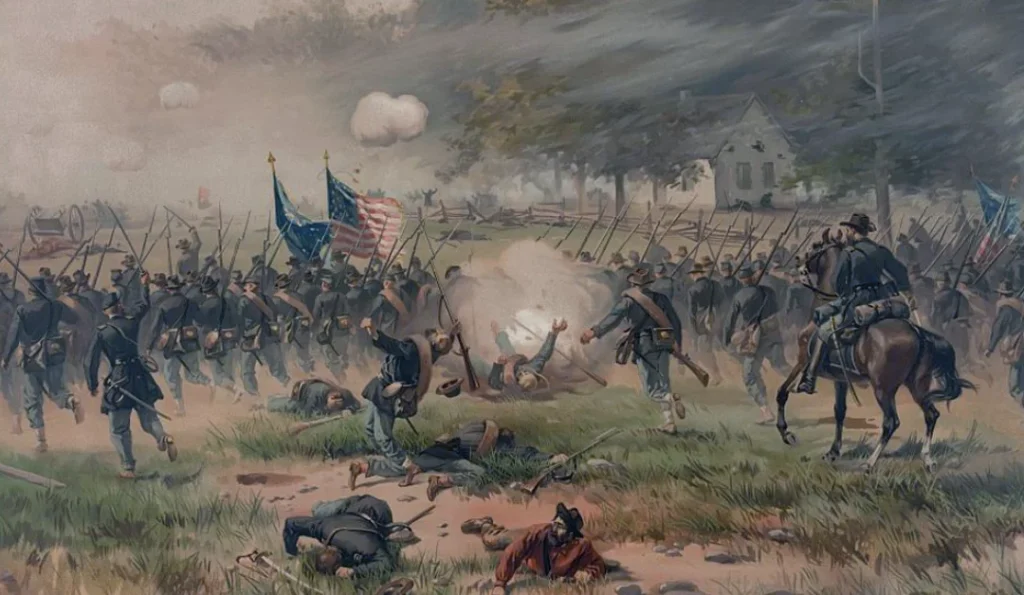September 17, 1862
The Battle of Antietam, also known as the Battle of Sharpsburg, was the first major battle of the American Civil War to take place on Northern soil. Fought near the town of Sharpsburg, Maryland, and Antietam Creek, on September 17, 1862, it was the bloodiest single day of battle in the war.
Emboldened by the Rebel victory at the Second Battle of Bull Run (August 28 to 30, 1862), Confederate commander Robert E. Lee decided to take the war to Northern soil in the late summer of 1862. On September 4, the Army of Northern Virginia began crossing the Potomac River and entered Maryland. Beyond Lee’s military goals, the invasion was driven by economic and political motives. The Southern armies were in need of provisions. Taking the war north would allow Virginia farmers to harvest their crops, unmolested by Union troops. Additionally, the invasion would enable Southern troops to commandeer supplies from Northern farmers. Lee also hoped that giving Northerners a taste of war would serve to diminish their resolve. Finally, a victory on Northern soil might induce European powers to lend support to the South.
Upon entering Maryland, Lee proceeded to Frederick, where he split his army into four major attack groups. Lee assumed that the Union forces, still in disarray from the stinging defeat at Bull Run, would be unable to move from Washington, DC in time to endanger his divided army.
Meanwhile, alarmed by the vulnerability of the nation’s capital, President Abraham Lincoln turned to Major General George McClellan to reinvigorate the Federal forces to stop Lee’s advance. Known for his organizational skills, McClellan quickly rebuilt his demoralized Army of the Potomac into a formidable force. Fortune smiled upon the Federal cause when McClellan came into possession of a captured copy of Lee’s plans on September 13. Knowing that Lee had divided his army, McClellan determined to take the initiative and advance to a position that would prevent the Rebel army from reuniting before he could defeat it in detail.
Suspecting McClellan’s intentions, Lee slowed the Union army’s advance through the passes of South Mountain while the Army of Northern Virginia reunited. On September 15, both armies began forming battle lines along Antietam Creek, near Sharpsburg in central Maryland. The battle began early in the morning on September 17, when a murderous artillery barrage and a subsequent advance by General Joseph Hooker’s troops drove Stonewall Jackson’s men from their positions. Jackson, however, was reinforced about 7:00 a.m. and drove Hooker’s forces back. A Union counterattack at about 9:00 a.m. regained some of the lost ground. Meanwhile, pitched fighting erupted along a road that afterward became known as Bloody Road. The action raged for over three hours, with both sides taking heavy losses.
Southeast of Sharpsburg, Union troops, under the command of General Ambrose Burnside, began trying to cross Antietam Creek over a bridge (now known as Burnside Bridge) at 9:30 a.m. The Confederates repulsed numerous Federal attempts until 1:00 p.m. When Burnside’s troops finally crossed the bridge, they drove the Rebels back nearly to Sharpsburg. At about 4:00 p.m. though, Confederate General A.P. Hill’s division joined the fray and drove the Federals back to near the bridge. By then, both armies were spent, and the fighting subsided.
Ohio units that participated in the Battle of Antietam included:
Infantry units:
- 5th Regiment Ohio Volunteer Infantry
- 7th Regiment Ohio Volunteer Infantry
- 8th Regiment Ohio Volunteer Infantry
- 11th Regiment Ohio Volunteer Infantry
- 12th Regiment Ohio Volunteer Infantry
- 23rd Regiment Ohio Volunteer Infantry
- 28th Regiment Ohio Volunteer Infantry
- 30th Regiment Ohio Volunteer Infantry
- 36th Regiment Ohio Volunteer Infantry
- 66th Regiment Ohio Volunteer Infantry
Artillery units:
- 1st Ohio Independent Light Artillery
- Battery L, 1st Ohio Light Artillery
Cavalry units:
- 3rd Company Ohio Cavalry
Although the battle was tactically a draw, as neither side could claim victory, it was a strategic Union victory because McClellan halted Lee’s northern campaign. On September 18, Lee began leading the Army of Northern Virginia back across the Potomac River into Virginia. The Battle of Antietam was the bloodiest one-day battle of the American Civil War. McClellan’s army of approximately 75,000 men suffered 12,401 casualties, including 2,108 killed. Lee’s smaller army of approximately 55,000 suffered 10,316 casualties, including 1,546 killed. Although the battle was tactically inconclusive, President Lincoln considered it strategically important enough to prompt him to issue his Preliminary Emancipation Proclamation on September 22, 1862.
